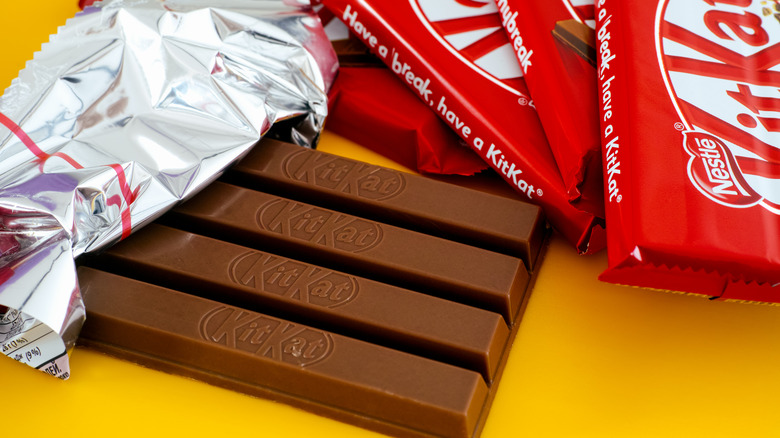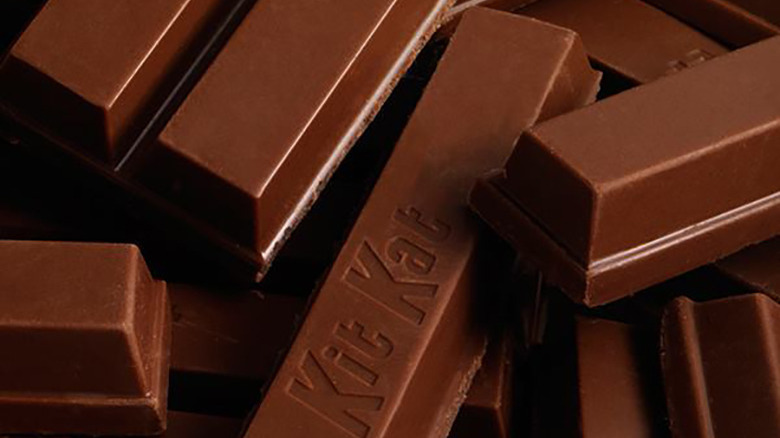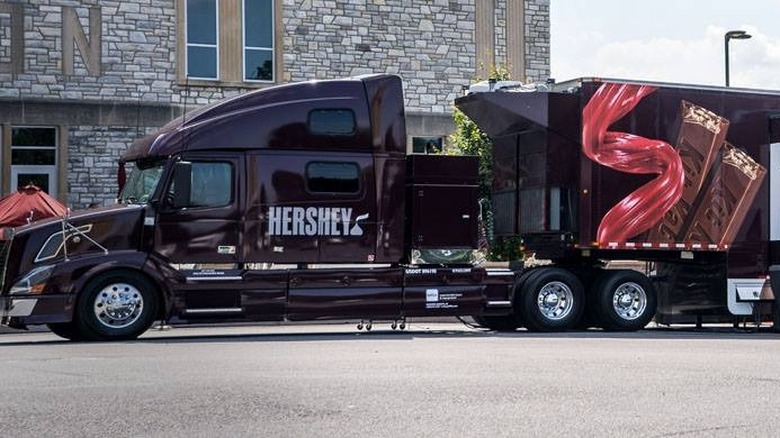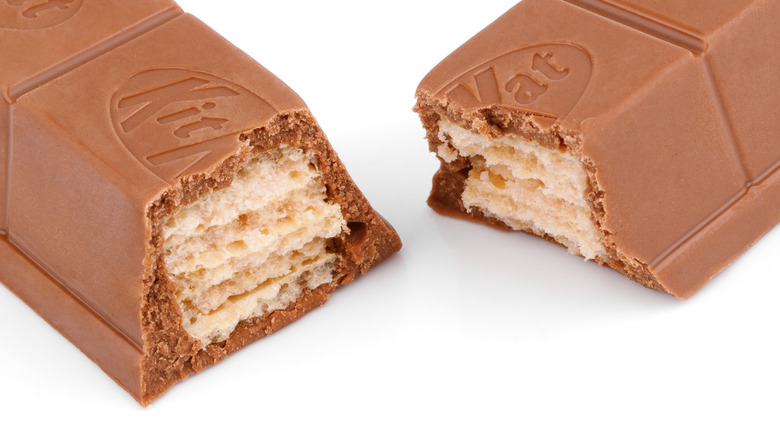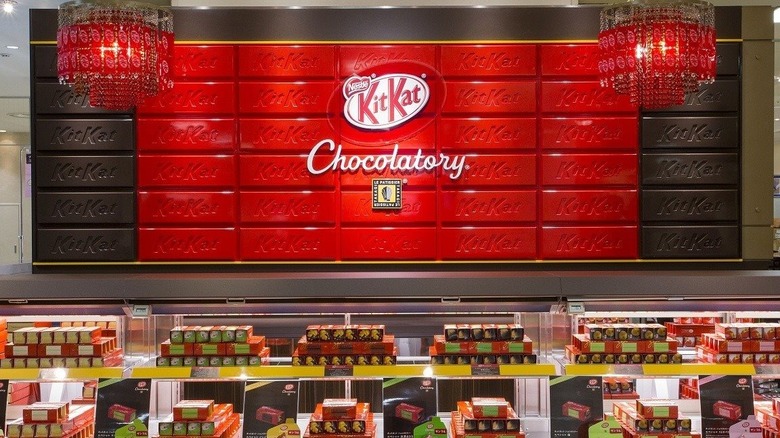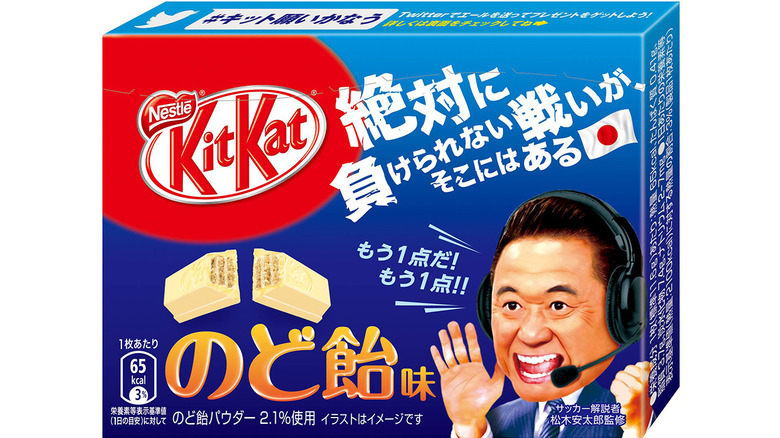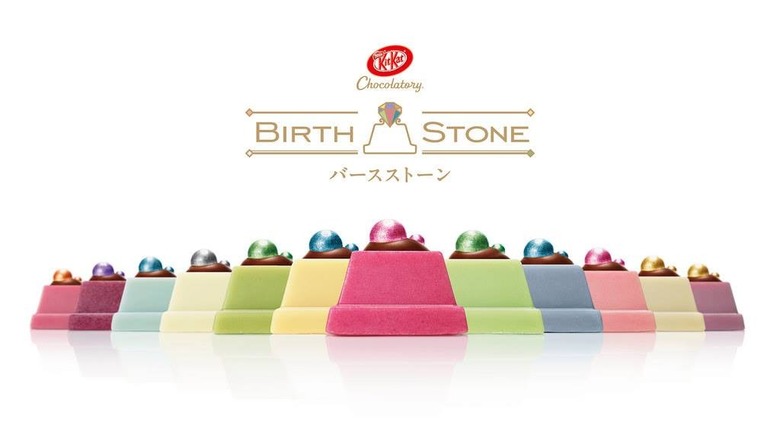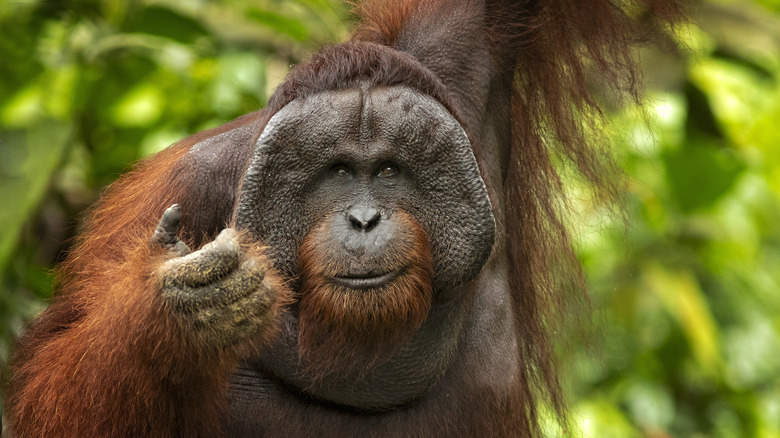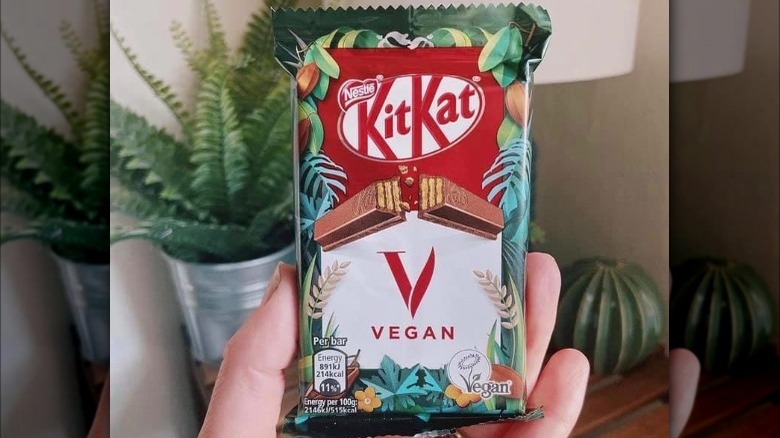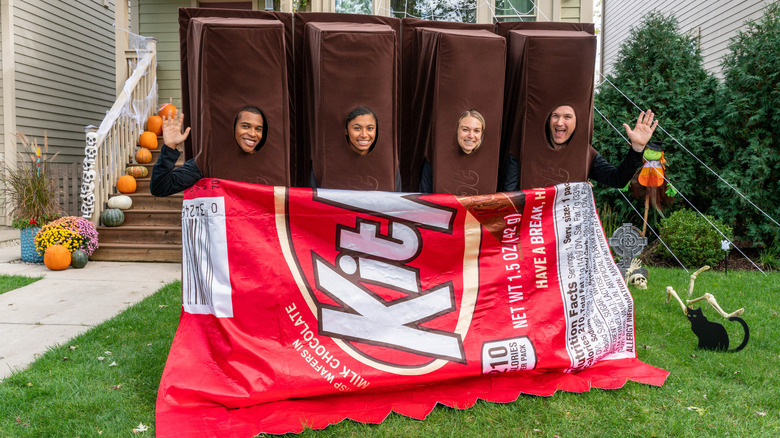The Untold Truth Of Kit Kat
Kit Kat's "Gimme a break" jingle has been a constant presence in the commercials for this candy. And why wouldn't it be? With a Kit Kat, "break" can mean both taking time off to relax and snapping off one of Kit Kat's four trapezoidal bars. But that earworm of a jingle is just the beginning of Kit Kat's influence on our culture.
As Time pointed out when it named Kit Kat one of the "most influential candy bars of all time," this little treat is a pioneer in the candy industry. Why? Four words: Kit Kats are international. Now, you might laugh at that, as many candy bars are sold in multiple countries. But here's the thing: Kit Kat was the first to launch in multiple markets around the world. It established footholds in both the U.S. and Europe and continued to expand its market from there.
Kit Kats also have range. Yes, milk chocolate is arguably one of the best-known Kit Kat flavors, but as Time explains, it's hardly the only one you'll find, especially overseas. For example, in Japan, there are Kit Kats that taste like wasabi, soybeans, and more. How did we get to a point where Kit Kats could be found in such interesting flavors? Follow us as we trace the fascinating history of this shareable candy.
Kit Kat was created in England
Yes, like The Beatles, Kit Kats are also originally from England, according to Hershey. They first hit the market in 1935 under the name Rowntree's Chocolate Crisp. This is because Rowntree was the company that first produced what we know today as Kit Kats, explains Spoon University. Per Hershey, Rowntree started calling its chocolate crisp a Kit Kat in 1937.
Why did Rowntree decide to rename its candy? The term Kit Kat predates the sweet, according to Spoon University. As the book "Club Life of London" explains, a man named Christopher Katt made meat pies for The Kit-Kat Club. These pies became known as Kit-Kats. But wait, what does a chocolate candy have in common with a meat pie? Simple, the marketing for candy back in the 1900s was similar to the sales pitch for protein bars today. The idea was that a candy bar could be eaten on the fly so workers wouldn't lose time and money taking a lunch break. Per Spoon University, changing the candy's name to Kit Kat, a term associated with savory pies, implied that the candy was the equivalent of a meal.
Hershey distributes Kit Kat in the U.S.
Today, Kit Kat is sold in more than 80 countries, according to Nestlé. Of course, the United States is one of those countries, but the distribution of Kit Kats here is different than in other areas of the world. While Nestlé owns the Kit Kat brand, Hershey owns the rights to make and distribute Kit Kat in the U.S., according to Spoon University.
The agreement dates back to the '60s when Rowntree was having a tough time penetrating the U.S. market. The company decided to sell the rights for U.S. Kit Kat production to Hershey in an effort to improve sales in America. Strangely, instead of just selling these rights for a period of time, Rowntree gave U.S. Kit Kat production rights to Hershey in perpetuity, meaning the deal has no end date. When Nestlé bought Kit Kat, it inherited the agreement with Hershey. Legal details aside, however, the original deal between Rowntree and Hershey successfully turned Kit Kat into a popular treat in America.
Even if Hershey doesn't technically own the Kit Kat brand, the company still sells a lot of this popular product. According to Forbes, Hershey spent $60 million in 2018 to expand its plant in Hazelton, Pennsylvania. The expansion increased the production of Kit Kats at the plant from 240,000 daily to 390,000 per day.
The filling in Kit Kats contains ground Kit Kats
Anyone who's ever eaten a classic Kit Kat will probably know that it's made with chocolate and wafers. But the filling has another ingredient you might not have noticed. A Nestlé U.K. spokesperson told Today that the filling between the wafers consists of "cocoa liquor, sugar, and a small amount of re-worked Kit Kat." In other words, Kit Kats that are broken during production are incorporated into the recipe for more Kit Kats.
This "revelation" about Kit Kats was part of a BBC documentary that gave a behind-the-scenes look at the making of this well-known candy. The documentary filmed the production of Kit Kats at a factory in York in the U.K, according to Today. We can't confirm that Hershey uses the same process for U.S. Kit Kats, though it seems likely. When a Hershey spokesperson was asked by Today about this topic, they stated, "While we make and sell Kit Kat bars in the U.S. under a global license from Nestlé, the manufacturing process for Kit Kat is proprietary under this license."
Of course, all of this does beg one question: What was in the filling for the very first Kit Kats? The Nestlé spokesperson confirmed to Today that the first Kit Kats ever made didn't include "re-worked Kit Kats."
There are Kit Kat boutiques around the world
A Chocolatory sounds like it should be part of Willy Wonka's famous chocolate factory. Surprisingly, it is an actual place — or rather places — where visitors can try a wide variety of Kit Kats. According to Nestlé, the very first of these Kit Kat-themed boutiques opened in 2014 in Tokyo's Ikebukuro district in Japan. Since then, the store has opened four additional locations in Japan. There are also outposts in other countries like Canada and Australia.
A quick visit to these locations' websites shows just how many variations of Kit Kats are available for candy lovers. The Canadian Chocolatory website, for example, has a create-your-own Kit Kat option and special flavors influenced by Canada's cuisine. The one for Australia also lets you make your own Kit Kat. According to Japan Today, Nestlé celebrated the opening of the Chocolatory in Ginza, Japan, with Sushi Kit Kats.
Before you imagine fish-flavored Kit Kats, these were actually sweet Kit Kats that were made to look like tuna, egg, and sea urchin sushi. The "tuna" ones were raspberry-flavored, the "egg" ones were banana-flavored, and the "sea urchin" ones were Mascarpone Cheese and Hokkaido Melon-flavored. Other ingredients used to give the Kit Kats the appearance of sushi included seaweed and white chocolate-coated puffed rice.
Gold-covered Kit Kats were a thing
In the story of King Midas, the title character gets the ability to turn everything he touches into gold. This seemingly wonderful gift, however, becomes a curse when food keeps transforming into gold before he can eat it. These next Kit Kats could give you a taste of the King Midas lifestyle.
Nestlé rolled out a Kit Kat in 2015 that was literally covered with gold — edible gold leaf to be exact. Available in Japan for a limited time (only 500 were made), these Sublime Gold Kit Kats were unusual in that they were sold as individual bars instead of four breakable pieces. The small serving could have been for cost reasons. The price for Sublime Gold Kit Kats was roughly $16, so had they been sold as a package of four bars, they would have cost around $64.
In addition to being covered with gold leaf, The Wall Street Journal reported that "Sublime Gold" Kit Kats tasted different than the classic milk chocolate variety of this candy. Specifically, they were said to have been more bitter and rich in flavor.
Kit Kats' shape was the subject of a lawsuit
If you've ever been to Norway, you might have tried a candy called Kvikk Lunsj. As the BBC reports, this well-known sweet produced by Mondelez first came on the scene in 1937, a couple of years after the chocolate that became known as Kit Kat was first sold. While the two chocolate products don't taste the same, their appearances are similar enough that Nestlé took legal action.
Specifically, Nestlé attempted to trademark the shape of their Kit Kat in 2002. Remember, Kit Kats are not perfect rectangles. In fact, they're trapezoids. And if you guessed that Kvikk Lunsj bars also have that design, you'd be absolutely right. Initially, Nestlé won the trademark, which would mean a mandatory candy makeover for Kvikk Lunsj. Mondelez, however, appealed the decision to grant Nestlé the trademark, which is when the story took an unfortunate twist for Nestlé.
In order to get the trademark, Nestlé had to prove that Kit Kat was a distinctive brand in every country that was a member of the EU at that time, according to the BBC. A lower EU court ruled in 2016 that Nestlé had not provided evidence to show that Kit Kat was a distinctive brand in Greece, Belgium, Portugal, and Ireland. Because of this, the original decision to grant Nestlé the trademark was annulled.
There were cough drop-flavored Kit Kats
Although Mary Poppins sang that "a spoonful of sugar helps the medicine go down," it's highly unlikely that the iconic nanny character thought of sugary treats as medicine. Then again, Mary Poppins probably never encountered anything like cough drop-flavored Kit Kats.
This addition to the Kit Kat line of overseas flavors was sold in Japan in connection to the 2018 FIFA World Cup. The wrappers featured the soccer commentator Yasutaro Matsuki. What do cough drops have to do with soccer? Well, if you've ever been to a soccer game (especially a huge one like the World Cup), you know that fans like to cheer and scream. The idea behind this Kit Kat, according to SoraNews24, was to give fans a way to soothe their throats while they enjoyed FIFA World Cup matches. The bars actually had real powdered cough drops mixed into the white chocolate coating.
There's a Kit Kat for every birthstone
Kit Kat is known for introducing new flavors on a regular basis, especially in Japan. As Japan Today reported back in 2017, Nestlé decided to create a special Kit Kat for every month of the year with the launch of birthstone Kit Kats.
Sold in Japan and online, these twelve colorful candies had an extra decorating touch that classic Kit Kats don't usually have: a dragée. And even if you've never heard the word "dragée" before, you've probably seen them on various desserts. They're small shiny spheres made of sugar. In the case of this Kit Kats candy line, they came in a variety of colors that corresponded to gemstones. For example, September's birthstone is the sapphire, so the September birthstone Kit Kat was blueberry and decorated with a blue dragée.
Other birthstone Kit Kat flavors included raspberry (January), haskap berry (February), grapefruit mint (March), rum raisin (April), pistachio (May), coconut (June), Okinawan citrus fruit (August), peach (October), chestnut (November), and purple yam (December), according to Japan Today. One of the more unusual flavors from this line is the one for July, which has a tomato-flavored Kit Kat to represent a ruby. This is not to be confused with the Sublime Ruby version of Kit Kats, which are made from ruby cacao beans and have a sweet yet tart flavor, according to Forbes.
Greenpeace released a Kit Kat parody video
Imagine you're watching what you think is a commercial for Kit Kat where a person opens up the candy's wrapper to reveal an orangutan's finger instead of chocolate. If you're guessing that this was not an ad spot approved by Nestlé or Hershey, you're completely right. In fact, this wasn't a commercial for Kit Kat at all, but a parody created and released by Greenpeace in 2010, according to CNN.
The reason for the mock commercial was Nestlé's use of palm oil. Greenpeace claimed that the palm oil used in many Nestlé products came from the palm oil producer Sinar Mas. Greenpeace also said that Sinar Mas was destroying the rainforest home of orangutans in Indonesia. Nestlé said in a statement that the palm oil they use in Kit Kats and all their other products was purchased from Cargill rather than Sinar Mas.
CNN says that although YouTube removed the Greenpeace mock ad when Nestlé contacted them about copyright, Greenpeace re-uploaded it on Vimeo, according to CNN. The fake Kit Kat ad was also reposted on YouTube, as well as elsewhere online. Greenpeace also said on Twitter that Nestlé had used the copyright claim in an attempt to censor them. Nestlé UK, however, denied that this was the reason for contacting YouTube about the clip.
Nestlé released vegan Kit Kats
Chocolate like the kind used in classic Kit Kats is not vegan since it's made with milk that comes from cows. According to Alexander von Maillot, Head of Confectionery at Nestlé, "One of the most common requests we see on social media is for a vegan KitKat." In 2021, Nestlé released a special new version of Kit Kats that would fit into a vegan meal plan.
"Our challenge when we set out to create a vegan-friendly KitKat was to recreate this iconic product using plant-based alternatives," explained Louise Barrett, Head of the Nestlé Confectionery Product Technology Center in York. "To achieve this, we worked very hard to get the right balance between the milk alternative and the cocoa." Eventually, Nestlé's confectionery research and development center in York, U.K., created Kit Kat V, a certified vegan candy that contains a "rice-based alternative" instead of cow's milk.
Kit Kat V was initially launched in the United Kingdom, Poland, Estonia, Latvia, and Lithuania, according to Nestlé. This was followed by a rollout in Australia and Brazil. Nestlé also featured these plant-based candies at its Chocolatory locations.
Kit Kat costume named Most Creative
In 2021, Hershey introduced a Kit Kat-themed costume just in time for Halloween (via PR Newswire). While Hershey could have created a one-person, boxy costume that resembled its iconic candy, the company created a four-person Kit Kat costume where each individual is a chocolate wafer instead. Like a real Kit Kat, the four people can break apart, giving them freedom of movement. They can also come back together inside a magnetic Kit Kat candy wrapper. This design caught the attention of the Halloween & Costume Association, which named the Kit Kat costume the "Most Creative Four-Person Costume of 2021." Aneisha McMillan, public relations director of the Association, said at the time that "group costumes are trending," adding that the Kit Kat costume "is turning heads."
To help promote the Halloween costume, Hershey ran a contest on social media. The winner (who needed to tag three friends on Kit Kat's official Instagram and Facebook channels) would receive a free Kit Kat costume for Halloween.
